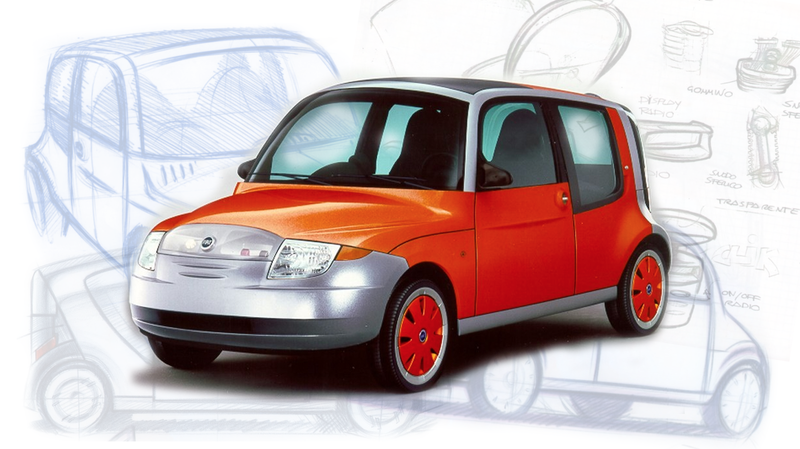
One of the things I’ve learned about myself over my life is that I’m much more interested in cheap crap than nice things. I’m not sure if it stems from some deep-seated inferiority complex or what, but I’m generally more impressed by things made with severe restrictions than unlimited budgets. Maybe that’s why I’m so taken with this 1999 Fiat concept, the Ecobasic.
I would like to make clear, though, that cheap doesn’t have to mean shitty; even though I’m absolutely certain that I in no way deserve the very best anything—what am I, a sultan?—that doesn’t mean I like garbage. Something that’s cleverly and elegantly designed, within non-trivial budgetary constraints, is the ideal, and it’s what this Fiat does so damn well.
Advertisement
It’s weird looking to mainstream tastes, sure, no question, but it’s also a deeply rational design. It’s got a space-maximizing rounded-cube shape, even featuring a really fun rear bubble-window hatch, and the body design delivers an impressive 88 percent of the volume for use by passengers and cargo.
Despite being so tall and kind of awkward looking, the Ecobasic has a Cd of only 0.28, which is the same as a Chevy Volt, a car with a lot of careful attention paid to aero design.
Everything about this weird little car has been designed with efficiency and ease-of-use in mind. The body panels are made from (recycled and recylable) dyed plastics, meaning the car doesn’t need to be painted and if you get a ding or scratch, it’s that much harder to tell because the color permeates the panel. If it’s orange and you scratch it, there’s just more orange below. You could probably sand and polish out scrapes and gouges by hand.
The manufacturing was designed to be cheap and modular, and only one basic model was envisioned, though the layout of the basic model was designed to be flexible enough to serve a wide variety of roles.
Advertisement
With that in mind, the interior is really adaptable, with removable, foldable, flippable seating and plastic interior floors and headliners that would make it serviceable as a little cargo vehicle as well as a passenger car.
Also, look at those window cranks. I freaking love those window cranks.
Mechanically, the Ecobasic lives up to its name with a 1.2-liter 61 horsepower turbo diesel that was capable of 81 MPG, and could reach a limited top speed of 99 mph.
It wasn’t an engine for tinkering, though, since there’s no actual hood to access the engine. To get to the engine, you’d have to remove the ‘hood’ body panel, but for normal maintenance and fluid fill-ups/changes everything was accessible through a very clever little flip-up panel in the front that let you access oil, coolant, washer fluid, and the + and – battery terminals.
Advertisement
Some of the 10 prototypes built had a clear panel over these access points, but I’m not sure if that was intended for production.
The transmission was a sort of hydraulic-clutch assisted manual that could be used in a fully-automatic mode as well, which, it seems, was better for economy. It sounds a little like the previous-gen semi-auto transmissions that Smart used, and nobody liked those. But I’ll give the Ecobasic the benefit of the doubt.
The goal of the Ecobasic was to build a car that could be sold for as low as about $5,000 in 2000 or so, though, based on this contemporary review in the British newspaper The Telegraph, it doesn’t sound like anyone at Fiat really was all that interested in making it happen:
I have seen other launches where journalists are more enthusiastic about the product than the company. Usually, however, that’s when the car is a seductive rocketship that will almost certainly lead its maker into the hands of the receiver. Yet this is no such thing. The Ecobasic might look weird, and I doubt it would sell for £4,000 (more like six grand), but it’s also surprisingly level-headed in its engineering and good to drive – which makes it even more of mystery that Fiat doesn’t seem quite as keen on the idea as almost everyone else.
That’s a real shame, but hardly an uncommon one. Cars on the low-end of the market are notoriously hard to make money on, so it’s often difficult to get companies to invest much effort into them, which is why we end up with such miserable sleeping pills like the Nissan Versa.
When a company actually puts some real effort into designing a truly clever, useful, and, to me at least, appealing little car like this little plastic Fiat, you’d hope they would enthusiastically send it into market the best they knew how.
Sadly, that’s not really how the world seems to work, and that’s also why this little Fiat concept died after only about 10 test examples were built.
Advertisement
Oh well. This car was designed by the same team that designed the gloriously bonkers 1998-2010 Fiat Multipla, so at least they managed to get some of this wonderful rational-insantity aesthetic to market.
Give me this weird plastic orange pod over a grey Versa any day


















